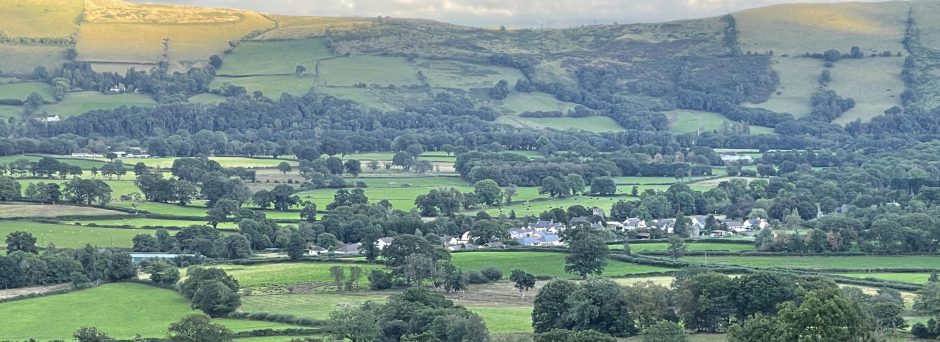Extract from “Llandovery and its Environs“
The river Mynys flows through the village of Porthyrhyd – and it is the stream that gives the village its name – “Gateway to the Ford”. Until recent re-organization, the river was the boundary between the parish of Llanwrda and the parish of Cilycwm. At the beginning of the present century, the Royal Oak Inn and one farm were on the Llanwrda side; the Drovers Farm, the Chapel and two small cottages were on the Cilycwm side. The Post Office was built in 1906 and after that, the village remained almost unchanged for many years. Eventually the two cottages became derelict and a coal shed for the use of the Chapel was built on the site. But the last decade has seen greater change – five new bungalows have been built, “The Drovers” has become a small-holding and the farm has taken the name of Porthyrhyd Farm – the name by which it was known in the 1850’s.
During the time of cattle droving, Porthyrhyd was a popular and convenient overnight stopping-place; if need be the cattle could be shod, early in the morning, close by.
Smyrna, the Baptist Chapel, is at the centre of the village. It was built as a place of worship in 1828, on land leased by Mr. Price of Berris, for one hundred and fifty years, for a payment of ten shillings a year. Prior to the building of Smyrna, the minister who would be officiating at Cwmsarnddu, would travel to Porthyrhyd and hold a service at the various homesteads around the village. After 1828, when Smyrna was ready, services were held there at three o’clock in the afternoon. Soon, eleven persons were baptized in the Mynys, according to the rights and creed of the Baptist Church: this has been the practice ever since. Now the Mynys skirts the west side of the chapel burial ground. In 1837 some renovations were made to the building and seats were installed.
For many years Smyrna shared its minister with Waunclynda in the parish of Llansadwrn. The services continued to be at three o’clock on Sunday afternoons, probably for the convenience of the minister who had to travel between five and six miles from Llansadwrn, and also for the convenience of members many of whom would have to walk three or four miles over rough and hilly ground.
The chapel was re-built in 1883 and a beautiful circular window was placed in the wall behind the pulpit. Towards the end of the nineteenth century, it was decided to share the minister with Cwmsarnddu, which was some three miles away. Ministers were very lowly paid at the time and many of them lived on small rented farms to help to sustain their families. The shared minister with Cwmsarnddu lasted until the early 1940’s when it was decided – and with strong recommendation from the Baptist Union, that both Smyrna and Cwmsarnddu should share ministry with Ebeneser, Llandovery. Since the induction of the present minister, the Reverend Goronwy Wynne, four other chapels have been added.
The Gymanfa Ganu was held once every four years at Smyrna, from 1894 until 1986. There were also eisteddfodau and concerts by local talents held during the winter months – and there was, at one time, a three class Sunday School, and regular prayer meetings.
The school, called Berrisbrooke, is some quarter of a mile away from the village: it was opened in 1875 as a church school and built on land leased by the Campbell Davies family of Neuadd Fawr, Cilycwm to the Camarthenshire Education Committee. Once every term the Vicar would visit the school in order to listen to the children recite the Catechism.
Being the only school in a very rural area, the children had to walk for miles from the surrounding farms and would carry their packed lunches with them: it was not until 1947 that school meals came to these rural areas. The school consisted of one, with a Head-teacher and a teacher and a sewing mistress attending for one afternoon a week.
During the 1941-1942 war years, many evacuees were hosted and housed in the local farms and a special English class was provided to meet their needs. During the winter months the school offered other facilities too – sewing classes, whist drives and draught tournaments – and a few welcome-home concerts for the soldiers of the neighbourhood.
In 1959 the school was closed: it was repossessed by Mr. Richard Campbell Davys in 1974 and he had it converted into a home. He lived there for about four years; since then it has been sold twice, latterly to the Rachers, a family from London who have settled well into the life of the community and are anxious to record its history and traditions. Their photographic archive will be an invaluable source of the story of Porthyrhyd in the future.
Like most areas, Porthyrhyd has seen a lot of changes. In 1961 electricity came to these parts of Carmarthenshire and mains water followed a few years later.
During the last few years, the present owners of “The Drovers”, Dr. Brinley Jones and his wife Mrs. Stephanie Jones have converted what was the cowshed into a large room which seats some sixty to seventy people. There they have arranged concerts, whist drives, lectures – given by notable people on various topics, harvest suppers and even a play depicting the life and work of William Williams, Pantycelyn, written and produced by Miss Norah Isaac of Carmarthen. Porthyrhyd – haven of the drovers – is once again the centre of busi-ness.
Postscript
The author of the article, which appeared in 1994 in a volume entitled “Llandovery and its Environs”, was Mrs Eleanor Edwards. She died in 2000 but had previously moved to Llandovery: with her leaving the Post Office in Porthyrhyd, the shop and Post Office ceased to be and is now a private residence.
